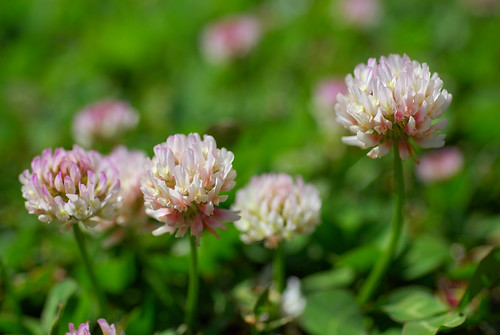 Vigorous and fast growing, tomatoes are heavy feeders and require fertilization from time to time during the season. There seems to be some conflicting information on just what type of fertilizer a tomato plant needs. How much nitrogen? How much phosphorus? How much, whatever that third number is? Potash? Potassium?
Vigorous and fast growing, tomatoes are heavy feeders and require fertilization from time to time during the season. There seems to be some conflicting information on just what type of fertilizer a tomato plant needs. How much nitrogen? How much phosphorus? How much, whatever that third number is? Potash? Potassium?
What Type of Fertilizer?
Assuming you're haven't gone completely organic, a trip to Home Depot or Lowe's presents several options: Vigoro's Tomato and Vegetable Plant Food (12-10-5), Miracle Grow for Tomatoes (18-18-21), Tomato Tone (4-7-10). They all offer differing N-P-K. So, which one's right?
A round up of the authorities suggests that a balanced fertilizer where all three numbers are equal or a fertilizer high in phosphorus, like a 5-10-5 is the way to go. While there is some variation between the extension services, all seem to point the home gardener away from high nitrogen, which makes sense. Nitrogen is typically associated with leafy growth. While tomatoes plants are among some of my closest companions, I like them for their fruit and not their wispy, whimsical foliage. Looks like my Vigoro 12-10-5 is going to be returned.
What the Experts Say . . .
Cornell University suggests, "On most soils, you can sidedress about 1/2 cup of 5-10-5 per plant and work shallowly into the top inch of soil when fruits are about 1 inch in diameter and again when harvest begins."
NC State calls for a balanced fertilizer: "For home gardens not soil tested, apply 5 pints of 8-8-8 per 100 ft of row and work it thoroughly into the top 8 inches of soil." Moreover, they suggest, "Sidedress tomato plants with 2 to 3 Tbsp. per plant of a complete fertilizer such as 8-8-8 or 10-10-10 after the plants have started to set fruit and 4 to 6 weeks thereafter throughout the growing season. Keep the sidedressing material 4 to 6 inches from the plant's stem to avoid fertilizer burn." (emphasis in original)
Similar to Cornell's advice, Ohio State tells us that, "Tomatoes respond well to fertilizer applications, especially phosphorus. Excess nitrogen fertilizer can result in plants with extremely vigorous vine growth but little fruit production. Apply 2-1/2 to 3 pounds of a complete fertilizer, such as 5-10-10, 5-20-20, or 8-16-16 per 100 square feet of garden area. Work the fertilizer into the soil about 2 weeks before planting. An additional sidedressing of a nitrogen fertilizer may be desirable after the first cluster of flowers have set fruit."
Lastly, Texas A&M offers this. "It is necessary to fertilize the garden before planting tomatoes. Apply the fertilizer again when fruit first sets. From that point on, an additional fertilization (sidedress) every week to 10 days is recommended. Plants grown on sandy soils should be fertilized more frequently than those grown on heavy, clay soils. A general sidedress fertilizer recommendation is one to two tablespoons of a complete fertilizer scattered around the plant and worked into the soil. If using a fertilizer high in nitrogen such as ammonium nitrate or sulfate, reduce the rate to one tablespoon per plant."
When to Fertilize?
In case you didn't get it from the passages above, fertilize before you first set out your tomatoes. This is probably critical. After that, give some more fertilizer when the first fruit sets and every few weeks after that.






















































